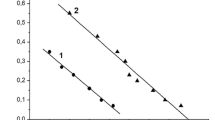Abstract
The effect of the peptide octarphin (TPLVTLFK), a selective agonist of the nonopioid β-endorphin receptor, on the activity of soluble (sGC) and membrane-bound guanylate cyclase (mGC) of peritoneal macrophages from mouse, rat, and guinea pig has been studied. It has been found that, in the concentration range of 10–1000 nM, octarphin increases the activity of sGC and has no effect on the activity of mGC in macrophages of these species. The activating effect of the peptide toward sGC was dose-dependent and was maximal at a concentration of 100 nM. These results indicate that the increase in the concentration of guanosine 3',5'-cyclophosphate in macrophages in the presence of octarphin occurs through the activation of sGC. It can be stated that the activating effect of octarphin on peritoneal macrophages is accomplished in the following way: an increase in the activity of inducible NO synthase → an increase in NO production → activation of sGC → an increase in the intracellular cGMP level.
Similar content being viewed by others
Abbreviations
- cGMP:
-
guanosine 3',5'-cyclophosphate
- iNOS:
-
inducible NO synthase
- LPS:
-
lipopolysaccharide
- mGC:
-
mem-brane-bound guanylate cyclase
- NO:
-
nitric oxide
- sGC:
-
soluble guanylate cyclase
References
Navolotskaya, E.V., Kovalitskaya, Y.A., Zolotarev, Y.A., and Sadovnikov, V.B., J. Peptide Sci., 2008, vol. 14, pp. 1121–1128.
Li, C.H., Cell, 1982, vol. 31, pp. 504–505.
Hazum, E., Chang, K.J., and Cuatrecasas, P., Science, 1979, vol. 205, pp. 1033–1035.
Kovalitskaya, Y.A., Nekrasova, Y.N., Sadovnokov, V.B., and Navolotskaya, E.V., Biochemistry (Moscow), 2011, vol. 76, pp. 596–604.
Sadovnikov, V.B. and Navolotskaya, E.V., J. Peptide Sci., 2014, vol. 20, pp. 212–215.
Navolotskaya, E.V., Russ. J. Bioorg. Chem., 2015, vol. 41, pp. 467–473.
Schmidt, H.H. and Walter, U., Cell, 1994, vol. 78, pp. 919–925.
Nathan, C. and Xie, Q.W., Cell, 1994, vol. 78, pp. 915–918.
MacMicking, J., Xie, Q.W., and Nathan, C., Annu. Rev. Immunol., 1997, vol. 15, pp. 323–350.
Feelish, M. and Noaclk, E.A., Eur. J. Pharmacol., 1987, vol. 139, pp. 19–30.
Mayer, B. and Koesling, D., Advances in Second Messenger and Phosphoprotein Research, New York: Raven Press, 1993.
Kuhn, M., Circ. Res., 2003, vol. 93, pp. 700–709.
Garbers, D.L. and Lowe, D.G., J. Biol. Chem., 1994, vol. 269, pp. 30741–30744.
Vaandrager, A.B., Mol. Cell. Biochem., 2002, vol. 230, pp. 73–83.
Kobiałka, M., Witwicka, H., Siednienko, J., and Gorczyca, W.A., Acta Biochim. Pol., 2003, vol. 50, pp. 837–848.
Germain, N., Bertin, B., Legendre, A., Martin, B., Lagente, V., Payne, A., and Bichot, E., Eur. Respir. J., 1998, vol. 12, pp. 1334–1339.
Schultz, G., Methods of Enzymatic Analysis, Weinheim, Germany: Verlag Chemie, 1984, pp. 379–389.
Southam, E., Curr. Protoc. Toxicol., 2001, vol. 10, p. 5.
Lowry, O.H., Rosebbrough, N.J., Farr, O.L., and Randal, R.J., J. Biol. Chem., 1951, vol. 193, pp. 265–275.
Author information
Authors and Affiliations
Corresponding author
Additional information
Original Russian Text © V.B. Sadovnikov, D.V. Zinchenko, E.V. Navolotskaya, 2016, published in Bioorganicheskaya Khimiya, 2016, Vol. 42, No. 3, pp. 301–304.
Rights and permissions
About this article
Cite this article
Sadovnikov, V.B., Zinchenko, D.V. & Navolotskaya, E.V. The synthetic peptide octarphin activates soluble guanylate cyclase in macrophages. Russ J Bioorg Chem 42, 269–271 (2016). https://doi.org/10.1134/S1068162016030122
Received:
Accepted:
Published:
Issue Date:
DOI: https://doi.org/10.1134/S1068162016030122



